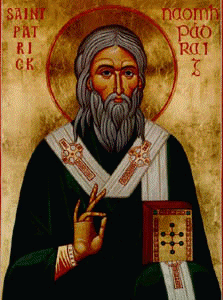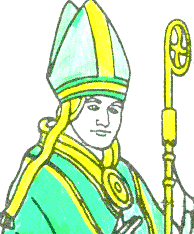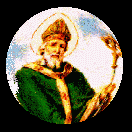|

Naomh (Saint)Pádraig(Patrick)
With his name written in Gaelic this
is perhaps a realistic image of
a man of the Celtic Church
which of course pre-dated
the dominated the Roman
Church in Ireland by several
Centuries.

Wishful thinking or perhaps
artistic license-this Mass Card
depicts Patrick as a bishop of
the Roman Catholic Church
which he was not.

A spiritual, heavenly Patrick as
portryed by the contemporary
Roman Catholic Church

"St Patrick Drives the Snakes
from Ireland"
A typical "Irish-American" point of
view drawn by Gabe Martin in
"Borderline"


Return to the top






Return to the top


Return to the top

Return to the top


Return to the top

Return to the top

 |
First things First:
March 17.=His Day

St. Patrick's Cross Part of the Union
Flag of the UK. for more on the cross
clickit here
Some
Essential Irish Gaelic:Lá
Fhéile Pádraig
(LAW
AY-luh PAW-rihg) = St. Patrick's Day
Beannachtaí
na Féile Pádraig oraibh! (BAN-uhkh-tee
nuh FAY-luh PAW-rihg O-rihv) = Happy St. Patrick's Day to You All!The first St. Patrick's Day celebration in
America was in 1737 hosted by the Charitable Irish Society
of Boston. Please exercise care in your celebration
of his day-
His Name:
"To
his irish contemporaries Patricus was known as Quadriga, Quotircke,
or some similar form (becoming later Cothraige), which was
really a Goidelic(Q-language) f what they no doubt thought to be a Brythonic(P-language)
word. But in the seventh century this equation was forgotten.The
Patricus of the Latin documents was
Hibernicised Pátraic,and absurd etymologies were advanced
for Cothraige. The fact indicates that there was not
any really strong and continuous historical tradition, linking the age
of the saint with that of the hagiographers. There were ancient peoples
names in the forms of Catraige, Cathraige,Cotrige, Cothmige, which
appeared as place-names in the various parts of Ireland. It is possible
that the career of Patrick was occasionally eked out by the deliberate
or unconscious confusion of these forms with Cothraige=Patricus".(James
F.Kenney, The Sources for the Early History of Ireland,Columbia
University Press, 1929)
Return to the top
Basic Facts-
Name: Maewyn Succat (He
adopted Patrick or Patricius upon becoming a priest)
Nationality: Roman Briton
Born: Around 415 AD
Travels: At the age of 16
he was brought to Ireland. He later returned to his home in Wales, travelled
to France and eventually came back to Ireland.
Died: March 17th, 493 (Disputed)
Education: Very little in
his early life. He later trained as a cleric in France
Occupation: Sheep herder
for Milchu on Slemish Mountain in Co Antrim and later preacher, baptiser
and bishop
Achievements: Posthumously
became Ireland's patron saint Responsible for the conversion of the island
to Christianity
Publications: Epistle to
Coroticus, Confessio
Interests/hobbies:
Preaching, Writing,Travel,Church-building
Hillwalking - once spent
forty days of Lent on Croagh Patrick
Legend says that it was
here that the saint rang his bell and the snakes of Ireland fled.
At the age of sixteen, just
before he was captured, "he committed a fault which appears not to have
been a great crime, yet was to him a subject of tears during the rest of
his life".( Butler, Lives of the Saints)
Patrick worried about his lack of education and
often refers to his inability to express his thoughts clearly in
his Confessio.(from Simms, The Real Story of Saint Patrick) -
Source: Irish Times
Return to the top
The
Primary Evidence
The Confession of
St. Patrick (biography). .. 455 AD
The Epistle to
Coroticus, . . . . . . . . . . . . . . . 456 AD
The Metrical Life
of St. Patrick by St. Fiech, . 493AD
The Tripartite Life of
St. Patrick by St. McEvin, 510AD
The Life of St.
Patrick by Jocelyn, . . . . . . . . 1185 AD
On the Life of St.
Patrick (Leabhar Breac) (Author: Translated by
Whitley Stokes)
References in the Annals
of Ireland- the Most important early history
of Ireland.
Annonomous Life
Return to the top
Citation from the Martyrology
of Donegal (written in 1630 completed
on April 19)
"Patrick,
noble Apostle of the island of Erinn, and head of the religion of the Gaeidhill,
the first primate ,and the first legate who was appointed in Erinn;
and it was he, moreover, that brought the people of Erinn, both men
and women, from the darkness of sins, and vices ,and paganism, tothelight
of faith, and piety, and knowledge of the Lord. Three
hundred and fifty holy bishops, andthree hundred priests, was
the number on whom he conferred orders. Three
hundred alphabets he wrote, and three hundred churches
he erected, as thes verses prove:
"Seven
times fifty holy learned bishops
This
holy man consecrated,
With
three hundred virgin presbyters,
Upon
whom he conferred orders;
"Three
hundred alphabets he wrote,
(church consecrations)
Beautiful
was the touch of his hand;
Three
hundred beautiful churches he founded,
He
raised them from the ground."
It
is he, moreover, that remained from Shrovetide till Easter without food,
as is (stated) in his own
Life,
and as Cuimin of Coindere proves in the poem whose begtinning is:-
"Patrick
of the fort of Mach, loved,
Son
of Calpurn of high rule,
From
Shrovetide till Easter (to be) without food,
No
Penance was greater than his penances."
Innumberable
also was the number of signs and miracles he performed; by resuscitating
the dead from death; by curing lepers, and the blind, and the
lame, and people of every disease in like manner. Two years
and six socre was his age when he resigned his spirit
in the year 493. Bishop Tasach was he who gave the body of Christ
to Patrick.
The
life of Ciaran of Cluain states, Chap. 8 that the Order of Patrick was
one of the eight oders which are in Erinn. ( The Martyrology of
Donegal, Trans:John O'Donovan, Eds. James Henthorn Todd, William Reeves,IIACS,Dublin,1864.)
Return to the top
Other Irish Saints
of March 17-
Tighernach-Priest
Gobban-son
of Nasc
Becán
Ruim
Faoiltighern-Virgin
(from
the Martyrology of Donegal)
Return to the top
Patrick
and Coptic Christianity
The Egyptian "Coptic" Orthodox Church was one
of the first established Christian Churches, together with the Churches
of Jerusalem and Antioch. In the first centuries of Christianity,
the Egyptian Church was very active and was working to spread Christianity,
beyond Egypt. Egyptian monks and laymen, were everywhere. This
was well documented by historians and the history of the church.
The Connection to France
A community of Coptic monks went to Gaul
where they founded a community on an island called "Lerins" in the
Mediterranean Sea . The island was nearGaul.
David Marshall, Ph.D. of the University
of Hull, England, has written a book which discusses the strong
connection between the St. Patrick and the Coptic Monks in
Lerins.
In "Liturgics" Fr. Dmitri Ross, OSJ . SSBM.
MA. Th. L. EM; discussed the Celtic Church. Fr. Dmiti
Ross, of St. Dunstan of Canterbury Orthodox Parish, Cromwell, New Zealand,
also has written of how monasticism strongly influenced the
Celtic Church and was a reason for its quick success.
Ross tells how monastisicism came to the Celtic Church from
the Egyptian Church, "Coptic Orthodox Church of Alexandria". The
connection came through Gaul,( France), where a good number
of Egyptian monks were living including those in
the Monastery at Lerins.
History
During this time , there were not many Christians
in Ireland and the British Isles in general, but Christianity was foundt
there that is, before the time of St. Patrick.
The writers and philosophers, Origan and Hippoluus of the third century,
wrote that of those who attended the First Ecumenical Council, "Nicea
Council", there were people from the British Isles.
This was also recorded by St.
Athanasius himself who was an Egyptian deacon and a key organizer
of that council. He introduced the "Orthodox Creed", at that
council, and also defended the faith against Arianism.
Athanasius was later the Pope of Alexandria.
The Connection
The Egyptian Church had many
monks in Lerins. St. Patrick, of the Celtic Church,
was born in Britain and was a Roman citizen
he later became a corner stone of Christianity
in the British Isles. St. Patrick wrote his autobiography, Confession.
When he was sixteen, the army of the Irish King Niall,
attacked the Britons. Patrick was captured.
He was then taken then to Ireland and was enslaved.
Later, he was able to escape and sailed to Gaul . Later he
went to the
Island of Lerins, where the Egyptian Coptic
monks lived.
St. Patrick lived with these monks learning
the "Coptic Christianity of Egypt". The Coptic Church originated directly
from the Church of Jerusalem, rather than from Rome and was also
not like the Byzantine Church.
Dr. David Marshall writes that the
"Celtic Christianity owes something to the Copts." Patrick's
residency with the Coptic monks on the Island of Lerins, "accounted
for his independence of Rome. St. Patrick prefered follow true orthodoxy.
Patrick returned eventually to Ireland.
Amator Bishop Auxerre ordained Patrick a priest and the church prospered
during his life. After the death of St. Patrick Rome turned
against the Celtic Church, because he had organized it according
to Coptic teaching. Were in the Liturgy and Baptism because
the Egyptians followed the Church of Jerusalem and not Rome.
Features the Celtic Church shared with the Coptic
Church were :
The priest faces the altar [to the East]
Married Priesthood.
Bishops officiate in vestments of oriental character:
in gold and silver.
fasting occurs on Wednesdays and Fridays.
Daily prayers, Mattins, Vespers etc.
Monks stay in separate cells.
Baptism is by immersion.
These are known as the rules of "Columba".
Rome held these practices to
be unacceptable Irish customs and strongly attacked the
Celtic Church. Rome was worried about the rapid growth of the Celtic Church
in Ireland and Britain and its expansion to Europe. The
Roman Pope sent Augustine and eighty Benedictine monks to the south
of England in order to counter the Celtic movement. By
mid 598AD, Augustine had established a base in Canterbury. Thousands from
the Celtic Church were rebaptized again- in the Church of Rome.
Return to the top The Reek:
Every year many thousands
of pilgrims, many in bare feet, climb the 2,500feet to the peak of
Croagh Patrick, to celebrate Saint Patrick's Christian mission in
Ireland.
Source=The Irish Times
Return to the top Sorry!
Just Myths
1.
Patrick used a shamrock to explain the Trinity:
Not
true but the shamrock was worn in Ireland as
a
symbol of the cross
2.
Patrick drove the snakes out of the country:
There
were never any snakes in Ireland -The snake metaphor was used to
represent paganism
3.
Patrick was the first to preach Christianity in Ireland: It
is known that there were Christians in Ireland before his time
4.
Patrick is thought to have been born and died on his feast day, March 17th.
Unlikely!
But
then again saints have always called upon us to
exercise
our faith more than our knowledge.
It is important to remember
that the peoples of the Island
of Ireland also celebrate
another very important holiday.
The deliverance of Ireland from the Absolutist James II
and ultimately from the exploitation of Louis
XIV is celebrated on July 12.
Go
here to learn of this holiday. Of course St Brigid of Kildare made more ale
than Patick and is also worth your consideration. Her day is February 1, Read
more here:
click
Return to the top |
Main Menu
Primary Evidence
Tme
Line Based on
Early
Sources
Sorry!
Myths Only
The Reek
Patrick
and Coptic
Christianity
Stories
about
St. Patrick
from
Lady Gregory
Primary
Sources
Bibliography
How toCelebrate
Poems
Sayings
Songs Stories
St
Patrick's Cross
Traditional Craft
Places
Associated
with St. Patrick
To My Irish
Studies Page
Feedback?
Send
me an e.mail

A Time Line of the Life of St.
Patrick and Primary Sources Relating to St. Patrick
-How ancient is your source? If it is not here it
is probably new revelation….which we should after all, hope for but it needs
documentation…
A.D.
1.
St. Patrick was born in North Britain, near the Clyde, . . . 376 or
thereabouts.
2. In the sixteenth year of his age he and
Lupita, his sister,were made captive by Scotch marauders, and, being led
intoIreland, were sold to Milcho in Dalaradia, now Ulster, . . 392
3. After six years' captivity, and being
twenty-one yearsold, he returns to his home in Britain, . . . . . . . . . .
397
4. After three months he went to Aremorica
with his parents, and was taken by the Picts two months into captivity. He was
taken captive a third time, and taken to Bordeaux, where he was set at
liberty, . . . . . . . . . . . . . . . 398
5. Passing thence to Tours, he became a monk
in the Monasteryof St. Martin, and after four years of monastic life returned to
the Island of Temar, which is supposed to be the same as Ireland, . . . . . .
. . . . . . . . . . . . . 402
6. St. Patrick was called by visions into
Gaul, and proceeded into Italy, . . . . . . . . . . . . . . . . . . . . . . .
. 403
7. According to the customs of monks at that
time, he spentseven years in wanderings over mountains and throughislands, and,
obeying the admonition of an angel, was
ordained priest by Bishop S. Senior, . .
. . . . . . . . . 410
8. Having studied three years, St. Patrick is
called byvisions into Ireland to preach the Gospel, . . . . . . . . 413
9. St. Patrick, through love of solitude,
returns intoBritain to Valle Rosina, . . . . . . . . . . . . . . . . . 414
10. Being received at Antissiodorum by St.
Amator,
A.D. 414, he remains there four years, and
passes to
St. Germanus in the forty-second year of
his age, . . . . . 418
11. Having spent nearly four years with St.
Germanus, St. Patrick departed for the Isle of Lerina, . . . . . . . 421
12. St. Patrick spent nine years in the Island
of Lerina,opposite Norbonne, and, knowing that the time for hismission to
Ireland was at hand, returned to Germanusat Aries, now Orleans, . . . . . . .
. . . . . . . . . . . 430
13. Palladius returned from Ireland, his
mission having failed, . . . . . . . . . . . . . . . . . . . . . . . . .
. 431
14. St. Patrick is sent by St. Celestine in
Ireland, . . . . . 432
15. Being consecrated bishop by the Bishop of
Tours, he bids farewell to St. Germanus in passing through Gaul, and,having
landed on the shore of Leinster, baptizes Sinellumin the autumn of the same
year, . . . . . . . . . . . . . . 432
16. St. Patrick proceeds to Ulster, preaches
the faith toMilcho, and makes many converts, . . . . . . . . . . . . . 433
17. St. Patrick preaches to King Leary at
Tara, . . . . . . . . 436
18. St. Patrick returned to Rome, and sent St.
Kranie and his five companions to preach the Gospel, . . . . . . . . . .
. 445
19. St. Patrick gives St. Bridget the veil in
the fourteenth year of her age, . . . . . . . . . . . . . . . . . . . .
. 450
20. Armagh is made a metropolitan see, and
councils are celebrated, . . . . . . . . . . . . . . . . . . . . . . . . 454
21. St. Patrick again visits Rome, probably for
the confirmation
of his council, . . . . . . . . . . . . .
. . . . . . . . . 455
22. St. Patrick dies, the eighty-second year of
his age, at Down, attended by St. Bridget, who had, he was conscious, foreknown
the time of his death, . . . . . . . . . . . . . 458
Some chronologies extend the life of St.
Patrick by fortyor forty-five years.
22.5
Hymn of St. Secundinus (earliest
work-5th century)
23. The Confession of
St. Patrick was written, . . . . . . . . 455
24. The Epistle to
Coroticus, . . . . . . . . . . . . . . . . 456
25. The Metrical Life
of St. Patrick by St. Fiech, . . . . . . 493
26. The Tripartite Life of
St. Patrick by St. McEvin, . . . . 510
27. The Life of St.
Patrick by Jocelyn, . . . . . . . . . . . 1185
Return to the top
|
|
